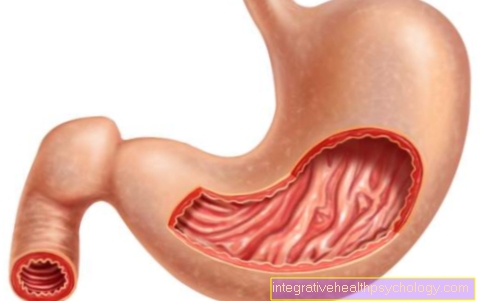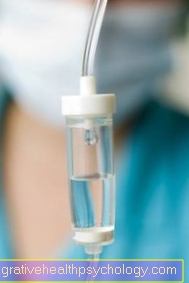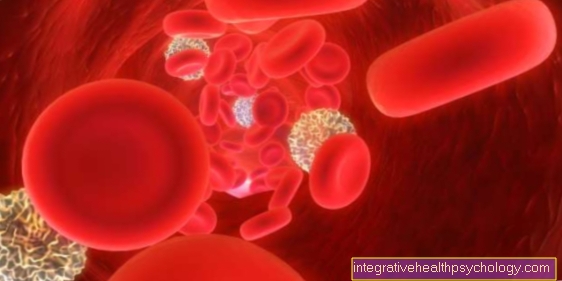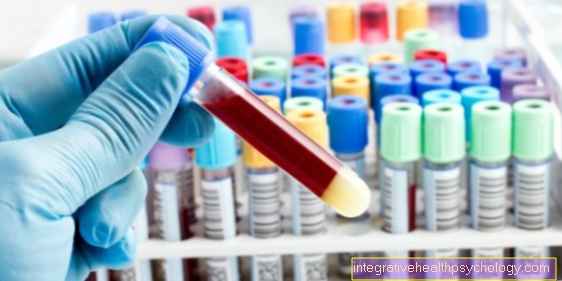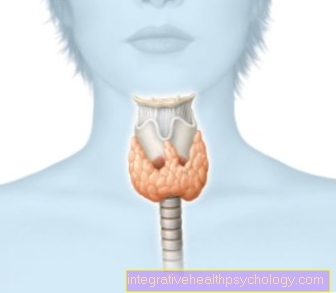Implantation of a stent after a heart attack
introduction
Does a person have one Heart attack suffered, it is important that acted as quickly as possible so that heart does not suffer any permanent damage.
After the occurrence of a heart attack can result in a Cardiac catheterization laboratory the affected people using the most modern methods Coronary arteries to be reopened.
An important pillar of infarct therapy is the Implantation of a stentthat keeps vascular constrictions open. The importance of this therapy has grown in recent years, so that it is today performed very often becomes.

The heart attack
A heart attack is the death of heart muscle cells, which occurs due to an insufficient supply of the cells. The cause of this is the clogging of a coronary artery, so that no blood can reach the heart muscle cells. A heart attack occurs when such a plaque is damaged in a vessel that has plaques on its inside as part of arteriosclerosis and a blood clot forms there as a result, which now either in the same place or by flooding with the Blood in a thinner section of the vessel clogs the vessel.
Typical symptoms of a heart attack are chest pain that can radiate to the (left) arm, lower jaw or abdomen and last for over 20 minutes. This can also lead to symptoms such as vomiting or increased sweating. A heart attack can trigger ventricular fibrillation, whereupon resuscitation must be started immediately, even by laypeople.
Read more on the topic: Symptoms of a heart attack
When diagnosing a heart attack, an EKG also helps, which then shows characteristic changes.
Since a heart attack is a life-threatening disease, it is important that immediate action is taken and that blood flow to the affected heart muscles is restored using appropriate medical procedures. As part of the emergency care on the spot, the emergency doctor can initiate drug therapy to dissolve the blood clot. If possible, it is advisable to take the patient to a hospital with a cardiac catheterization laboratory as quickly as possible, since the coronary arteries can be examined and reopened using a catheter; the doctor can decide to dilate the vessel with the help of a stent. Time is of the essence in treating a heart attack. The faster the vessels are free again, the fewer heart muscle cells die due to a lack of oxygen.
Implantation of the stent
When treating in the cardiac catheter laboratory, which ones too percutaneous coronary intervention, in short: PCI, is usually called over the bar the catheter and all other instruments inserted. The patient is awake here, only the puncture site where the doctor punctures the vessel locally anesthetized and the patient is given a sedative. Contain the inner walls of the vessels no pain receptors, which is why the cardiac catheterization and the Implantation of the stent itself is not painful are.
The first thing is a Guide wire in the dotted Inguinal artery introduced and advanced to the coronary arteries. When orientating in the body, one takes advantage of the fact that the metal wire works very well in one X-ray image you can see. The doctor can therefore check the position during the intervention take x-rays over and over again and so always knows exactly where it is in the vessel. Once in the right place, the catheter can now be inserted over the wire. In order to be able to assess the degree of constriction precisely, Contrast media through the catheter sprayed, so the vessel can be shown well. During the catheter examination of the heart, the administration of contrast agent is more often than warm feeling in the chest perceived.
If the position of the constriction and the degree of constriction is now precisely determined, the Therapy decision often on the Implantation of a stent, since with its help the vessel can be expanded again immediately and the expansion produced by the stent kept open for the long term becomes. Before a stent is implanted, the vascular constriction can be widened with a small balloon.
After selecting the appropriate stent, the stent introduced on a balloon and advanced to the narrowed point in the vessel. The vessel is dilated several times with the balloon by inflating the balloon under very high pressure. Does the affected area have the desired inside diameter reached, the catheter and balloon are pulled out again, the stent now remains at the previously narrowed point and keeps it open from now on. There are also stents that expand by themselvesThis means that they do not have to be expanded to the desired diameter with a balloon, but when such a stent is used, the vessel must be sufficiently dilated beforehand.
If everything went according to plan, the blood can flow through the vessel again and supply all cells with blood, the Heart attack was successfully treated. After the intervention, the patient is given a pressure bandage in the groin so that there is no bleeding at the puncture site.
How long are you in the hospital after a heart attack with a stent?
The Deployment of the stent self lasts mostly between 30 minutes and an hour. If multiple stents are deployed at the same time, the time may be increased. Since stent operations nowadays are usually performed using a catheter (a thin wire that is pushed from the artery on the thigh or on the forearm to the heart), general anesthesia is not necessary. As a result, the affected people are usually fit enough again to leave the hospital bed after the procedure.
The actual A.length of stay in hospital apart from the insertion of the stent is usually from additional diseases dependent. If the stent operation is performed as a planned procedure, it can even be done outpatient take place so that the patient is still on the same day can leave the hospital again. After that, however, physical exertion should be avoided for a certain period of time.
The emergency insertion of a stent is more complicated and therefore often more complicated. The subsequent hospital stay depends primarily on the underlying diseases and can vary between 1 or 2 days up to several weeks including intensive care monitoring.
What medication do I need after a stent implantation?
Be after a heart attack various drugs needed that support the heart. Depending on what complications develop. Especially for the stent will always blood thinner needed.
As long as the affected person is in the hospital, the blood is mostly with it Heparin diluted. This is administered in the form of injections into the fatty tissue on the abdomen, which is just under the skin.
Later there are various ways to thin the blood with medication. Are particularly popular ASS and Clopidogrel.
Meanwhile, more and more patients are also on Marcumar or NOAKS (New oral anti-coagulants), i.e. blood thinners that can be taken in the form of tablets, changed.
Do you need stent rehabilitation after a heart attack?
Regardless of whether a Stent is used is a rehabilitation very useful after a heart attack. However, rehabilitation is particularly helpful after a stent implantation. There you learn to reassess your own abilities. Particular attention is paid to physical fitness.
Since it is difficult to assess your own body immediately after the insertion of a stent, you should rely on a rehab where constant monitoring by medically trained staff is guaranteed.
Side effects and risks of a stent
Because the stent is a Foreign body in the vessel it can be there at any time Formation of a blood clot come. This thrombus can clog downstream vessels under certain circumstances, leading to the formation of a renewed infarction would lead. To prevent this complication, be patient during the intervention highly effective anticoagulants that prevent a blood clot from forming. However, these drugs also have side effects, so that increases Risk of bleeding Due to the poor coagulation, intolerance reactions can also occur.
After the stent placement must be for a few weeks Clopidogrel, an anticoagulant drug. The taking of ASS is usually found in patients with stents required for life. However, this medication may overlap with the medication that would be indicated anyway for the heart attack, so that the patient is often compared to other therapies no more tablets must swallow.
Alternatives
In the therapy of myocardial infarction there is next to the stent even more options.
First there is the possibility with the help of Medication the Dissolve blood clots. This method is particularly used in regions in which a cardiac catheter laboratory cannot be visited promptly. The Therapy with a stent as part of a percutaneous coronary intervention in a cardiac catheterization laboratory, however, you should preferred will if they to be reached within 90 minutes is.
In some severe cases it is also necessary to do one emergency bypass surgery is carried out.
Here, the constriction in the affected coronary artery is bridged with a healthy vessel that has been freely prepared from another region of the body. The bypass operation is necessary if, for example, one already has Heart failure pre-existing and in the course of this also a stent implantation do not ensure adequate blood supply can. Placing a bypass can even after stent implantation become necessary if, for example, the stent slowly closes due to scarring or it becomes a Angina pectoris which is a sign of insufficient blood supply to the heart muscles.
How can you prevent another heart attack?
To prevent another heart attack, the causative disease should be treated. This is usually one Heart disease, it can also be a high blood pressure, Diabetes mellitus ("Diabetes") or a Imbalance in blood fat levels exist. All of these diseases should be treated with medication.
During rehabilitation you can learn which types of movement and which physical activity is helpful. Also one balanced nutrition has a positive effect. Ideally, you should stop smoking after a heart attack at the latest. Too much alcohol is also harmful. In addition, one helps Weight loss to prevent another heart attack. Overall, all of these risk factors should be minimized. It also helps to regularly visit a heart specialist who will carry out competent preventive care.
What is the life expectancy after a heart attack and the following stent?
After a heart attack, life expectancy is lower compared to the rest of the population. About 5 to 10% of people who have had a heart attack will die from sudden heart failure within the next 2 years.
The fact that it is necessary to insert a stent suggests that the blockage of the coronary arteries is already quite advanced. For this reason, one should assume that life expectancy is lower than in comparable population groups. However, that leads Insertion of a stent for thisthat this high risk Another heart attack or sudden heart failure severe is decreased.
If the stent completely fulfills its task and no new calcifications settle in the vessel, they are Chances of an increased life expectancy are very good.
In addition, patients with a stent should see a doctor more often. Recurring risk factors can thus be prevented in good time. However, other diseases should not be ignored when assessing life expectancy, because depending on the personal risk profile of each individual, the long-term prognosis is better or worse.
Heart attack, stent and alcohol - are they compatible?
New studies show that moderate alcohol consumption can have positive effects after a stent implantation. Presumably, the alcohol prevents the smooth muscle cells inside the blood vessel from growing uncontrollably. This means that the stent usually stays open longer and the heart muscles are better supplied with blood. In general, however, is of We advise against alcohol consumption in the presence of coronary heart disease, as too much alcohol will make the disease progress faster.
Conclusion
The provision of a stent is very common in heart attack patients carried out with good results and as a rule preferred over drug therapy. After the stent implantation it is necessary Inhibit blood clottingso that no clots form on the stent, but this medication is indicated after a heart attack anyway, so it is used for stenting after a heart attack no additional medication in the long term need to be taken.





